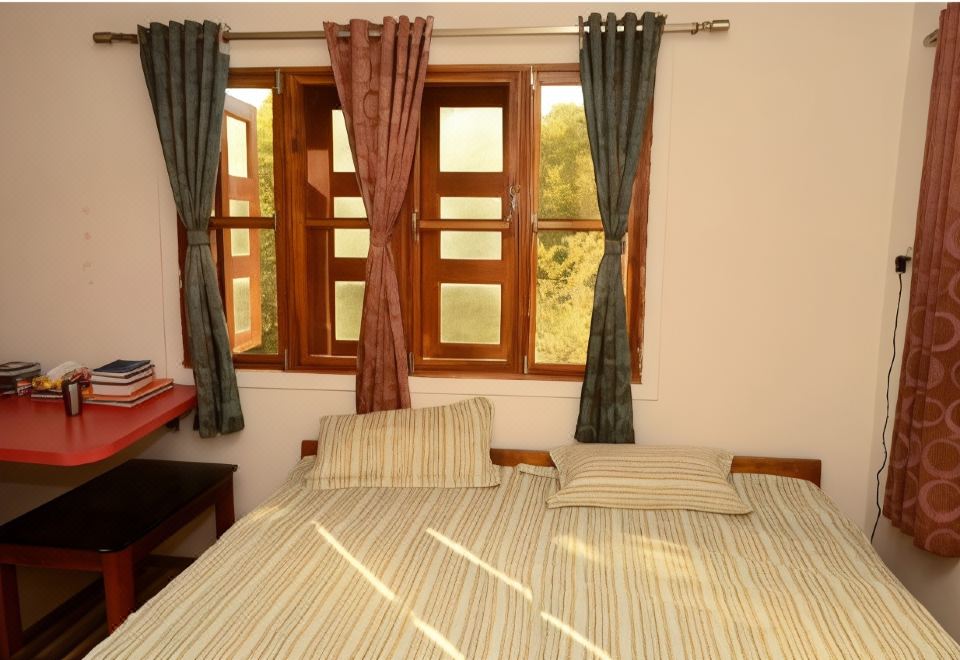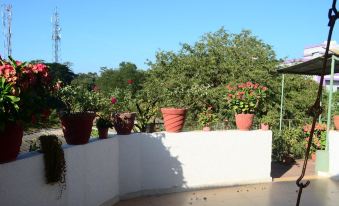Gurudev Chaya Guest House Ganeshpuri
1 Nacht
Zimmer und Gäste
1 Zimmer, 2 Erwachsene, 0 Kinder
Alle Unterkünfte in Thane
Gurudev Chaya Guest House Ganeshpuri
Ganeshpuri, 401206 Thane, Maharashtra, Indien
Auf Karte anzeigen
As a guru, Nityananda gave relatively little by way of verbal teachings. Starting in the early 1920s, his devotees in Mangalore would sit with him in the evenings. Most of the time he was silent, though occasionally he would give teachings. A devotee named Tulsiamma wrote down some of his teachings and his answers to her specific queries. Later, these notes were compiled and published in the Kannada language and came to be known as the Chidaksha Geeta.Mehr anzeigen
Preisgarantie







Ausstattung
WLAN in öffentlichen Bereichen
Gesamte Ausstattung
Umgebung
Flughafen: Internationaler Flughafen Chhatrapati Shivaji
(63,9 km)
Zug: Borivali Railway Station
(48,5 km)
Sehenswürdigkeit: Shri Nityananda Kutir, Pach Amba,
(100 m)
Karte
Zimmer
Bestimmungen
Service & Ausstattung

3
Deluxe-Zimmer (keine Klimaanlage)
1 Doppelbett
Verfügbarkeit prüfen
Bestimmungen der Unterkunft
Check-in- und Check-out-Zeiten
Check-in: 11:00 Uhr bis 18:00 Uhr
Check-out: 10:00 Uhr bis 11:00 Uhr
Richtlinien für Kinder
In diesem Hotel sind Kinder jeden Alters willkommen.
Für Kinder, die vorhandene Betten nutzen, können zusätzliche Kosten anfallen. Gib die Anzahl der Kinder ein, um einen genaueren Preis zu erhalten.
Kinder- und Zustellbetten
Zu den Richtlinien für Kinderbetten und zusätzliche Betten wende dich bitte an das Hotel.
Frühstück
ArtVegan, Vegetarisch
| Alter | Gebühr |
|---|---|
Erwachsene | Hotel kontaktieren |
Die Kosten für zusätzliches Frühstück sind nicht im Gesamtpreis enthalten und müssen vor Ort bezahlt werden.
Beschreibung der Unterkunft
As a guru, Nityananda gave relatively little by way of verbal teachings. Starting in the early 1920s, his devotees in Mangalore would sit with him in the evenings. Most of the time he was silent, though occasionally he would give teachings. A devotee named Tulsiamma wrote down some of his teachings and his answers to her specific queries. Later, these notes were compiled and published in the Kannada language and came to be known as the Chidaksha Geeta.
Some believe that Nityananda had the power to transmit spiritual energy (shaktipat) to people through non-verbal means. He could also be extremely fiery and intimidating in his behaviour, even to the point of throwing rocks on occasion. This was his way of deterring people who were not serious in their spiritual aspirations, or who came to him with ulterior motives.
In 1936, he went to the Shiva temple in the village of Ganeshpuri and asked if he could stay there. The family that looked after the temple agreed and built a hut for him. As his visitors and followers increased, the hut expanded and became an ashram. To the people around him, he was an avadhuta: one who is absorbed in the transcendental state.
Nityananda died on August 8, 1961. His samadhi is located in Ganeshpuri at the Samadhi Mandir. There is also a shrine dedicated to him in the Gurudev Siddha Peeth ashram at Ganeshpuri. His ashram, tourist hostel, and other buildings associated with his life in Ganeshpuri are preserved by the Shree Bhimeshwar Sadguru Nityanand Sanstha Ganeshpuri. This trust is also responsible for his samadhi shrine in Ganeshpuri, which is a pilgrimage site.
Some believe that Nityananda had the power to transmit spiritual energy (shaktipat) to people through non-verbal means. He could also be extremely fiery and intimidating in his behaviour, even to the point of throwing rocks on occasion. This was his way of deterring people who were not serious in their spiritual aspirations, or who came to him with ulterior motives.
In 1936, he went to the Shiva temple in the village of Ganeshpuri and asked if he could stay there. The family that looked after the temple agreed and built a hut for him. As his visitors and followers increased, the hut expanded and became an ashram. To the people around him, he was an avadhuta: one who is absorbed in the transcendental state.
Nityananda died on August 8, 1961. His samadhi is located in Ganeshpuri at the Samadhi Mandir. There is also a shrine dedicated to him in the Gurudev Siddha Peeth ashram at Ganeshpuri. His ashram, tourist hostel, and other buildings associated with his life in Ganeshpuri are preserved by the Shree Bhimeshwar Sadguru Nityanand Sanstha Ganeshpuri. This trust is also responsible for his samadhi shrine in Ganeshpuri, which is a pilgrimage site.
Service & Ausstattung
Beliebteste Ausstattung
WLAN in öffentlichen Bereichen
Internet
WLAN in öffentlichen Bereichen
Öffentliche Bereiche
Rauchverbot in öffentlichen Bereichen